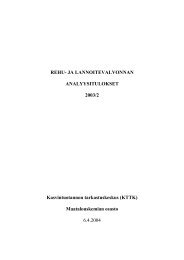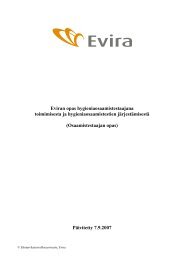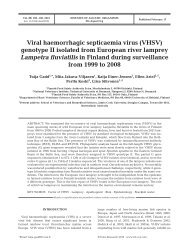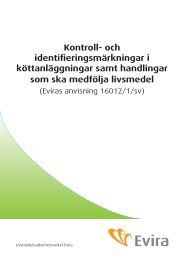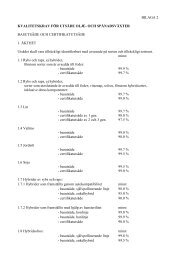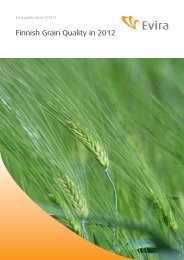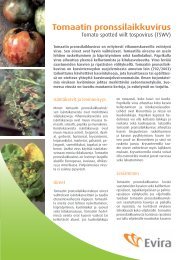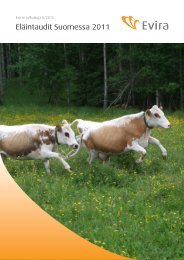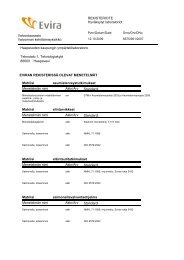Molecular characterization of endemic salmonella infections ... - Evira
Molecular characterization of endemic salmonella infections ... - Evira
Molecular characterization of endemic salmonella infections ... - Evira
Create successful ePaper yourself
Turn your PDF publications into a flip-book with our unique Google optimized e-Paper software.
2.5.2.2 Plasmid fingerprinting and identification <strong>of</strong> plasmid-mediated virulence genes<br />
Discrimination between plasmids <strong>of</strong> similar molecular mass, or determination <strong>of</strong> the degree <strong>of</strong><br />
molecular relatedness between plasmids <strong>of</strong> different size, may be achieved by digesting the<br />
plasmids with a restriction endonuclease and comparing the number and size <strong>of</strong> the restriction<br />
fragments generated (Maslow et al 1993; Threlfall et al 1994). The same restriction pattern should<br />
be seen in identical plasmids (Grimont et al 2000), but the results may be extremely difficult to<br />
interpret if a strain carries multiple plasmids (Threlfall et al 1994). However, a study by Rankin et al<br />
(1995) demonstrated the importance <strong>of</strong> plasmid fingerprinting, as plasmid analysis, on its own, can<br />
easily lead to the assumption that plasmids <strong>of</strong> the same molecular weight are the same plasmids.<br />
Their work showed plasmids <strong>of</strong> the same molecular weight could be unrelated whereas plasmids<br />
<strong>of</strong> different molecular weight could be closely related. In a study by Browning et al (1995),<br />
considerable plasmid diversity and evolutionary divergence was detected in the serotype-specific<br />
plasmid <strong>of</strong> Salmonella Dublin. Baggesen et al (1992) observed that plasmid pr<strong>of</strong>iling followed by<br />
restriction enzyme analysis was useful as it showed variations in the serotype-specific plasmid and<br />
also the presence <strong>of</strong> co-migrating plasmids <strong>of</strong> the same size as the serotype-specific plasmid.<br />
Plasmids carried by certain serotypes (serotype-specific plasmids) possess a highly conserved<br />
common area which carries genes responsible for the virulence <strong>of</strong> the serotype to certain strains <strong>of</strong><br />
mice (Williamson et al 1988). A DNA probe specific for these <strong>salmonella</strong> plasmid virulence (spv)<br />
genes makes rapid screening <strong>of</strong> a large number <strong>of</strong> strains possible. In epidemiological<br />
investigations, the presence or absence <strong>of</strong> serotype-specific plasmids can be useful (Threlfall et al<br />
1994). At least 12 serotypes contain virulence plasmids. The size <strong>of</strong> the plasmids range from 54 to<br />
98 kb, and phage type differences were found in plasmid carriage within a serotype (Lax et al<br />
1995).<br />
2.5.2.3 Ribotyping<br />
Restriction fragment length polymorphism (RFLP) associated with the ribosomal operon and<br />
detected by Southern blot analysis is called ribotyping (Stull et al 1988). Initially ribotyping,<br />
detecting variations in the copy number and location <strong>of</strong> 16S and 23S rRNA (rrn) loci, was used as<br />
a taxonomic tool (Grimont and Grimont 1986). The complete nucleotide sequence <strong>of</strong> a 16S<br />
ribosomal RNA gene obtained from E. coli was determined by Brosius et al and published in 1978.<br />
Stull et al (1988) tested the ability <strong>of</strong> E. coli rRNA to hybridize with heterologous DNA purified from<br />
genetically diverse gram-negative bacteria. These authors found cross-hybridization to occur<br />
between the E. coli rRNA probe and unrelated species. Therefore a probe derived from the E. coli<br />
ribosomal operon can be used widely (Maslow et al 1993).<br />
27



